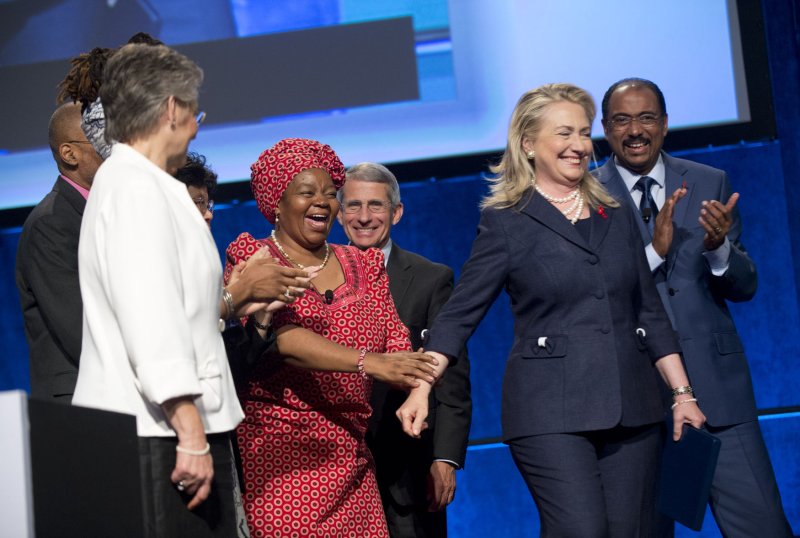Former U.S. Secretary of State Hillary Clinton (second right) is greeted by Sheila Tlou (center left), Director of UNAIDS Regional Support Team for Eastern and Southern Africa, as Dr. Anthony Fauci (C), Director of the National Institute of Allergy and Infections Diseases, and Michel Sidibe, Executive Director of UNAIDS, applaud after she delivered remarks during the XIX International AIDS Conference. (File/UPI/Kevin Dietsch) |
License Photo
The United Nations revealed Tuesday that seven countries in sub-Saharan Africa have seen new HIV infections among children drop by half or more since 2009.
This according to the latest progress report on the Global Plan launched in July 2011 to eliminate new HIV infections among children by 2015 while keeping their mothers alive.
The Plan aims for a 90 percent reduction in the number of children newly infected with HIV and a 50 percent reduction in the number of AIDS-related maternal deaths.
It focuses on 22 countries which account for 90 percent of new HIV infections among children. The current report presents the progress made by the 21 countries in sub-Saharan Africa as data from India was not available at the time of the report.
Botswana, Ethiopia, Ghana, Malawi, Namibia, South Africa, and Zambia have reduced new HIV infections among children by half since 2009, while Tanzania and Zimbabwe are making "substantial progress."
Overall, there were 130,000 fewer new HIV infections among children across the 21 countries in sub-Saharan Africa, 38 percent fewer than in 2009.
The Joint UN Program on HIV/AIDS (UNAIDS) noted that Ghana showed the greatest decline in new infections since 2009 at 76 percent, followed by South Africa at 63 percent.
“The progress in the majority of countries is a strong signal that with focused efforts, every child can be born free from HIV,” said Michel Sidibé, Executive Director UNAIDS, which spearheaded the Global Plan initiative along with the United States President’s Emergency Plan for AIDS Relief (PEPFAR).
“But progress has stalled in some countries with high numbers of new HIV infections. We need to find out why and remove the bottlenecks,” Sidibé added.
New infections among children in Nigeria remained largely unchanged since 2009. The country has the largest number of children acquiring HIV at nearly 60,000 new infections among children in 2012.
In Angola, new HIV infections have even increased. In other priority countries, infection rates are decreasing slowly.
Earlier this month U.S. Secretary of State John Kerry announced that the one millionth baby was born HIV-free due to PEPFAR’s support.
But the new report shows that although the number of pregnant women receiving antiretroviral therapy for their own health has increased since 2009, only half of all breastfeeding women living with HIV or their children receive antiretroviral medicines to prevent transmission of the disease.















